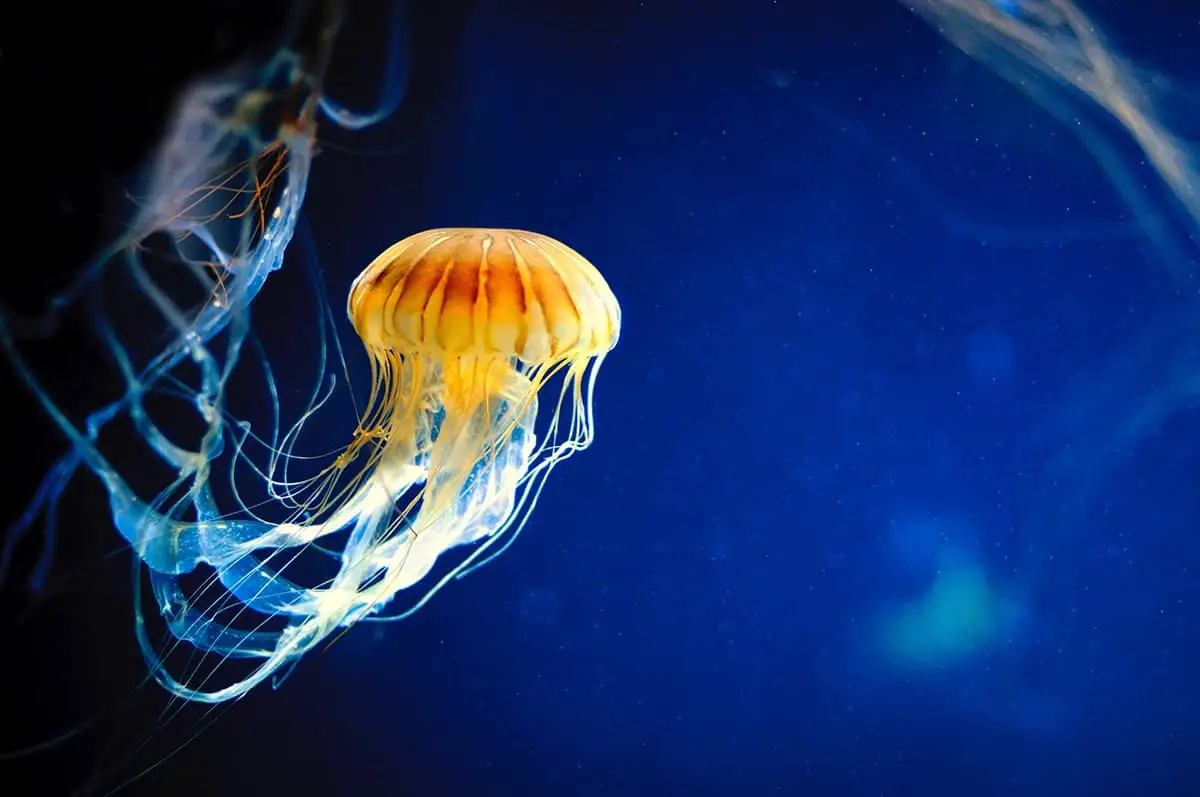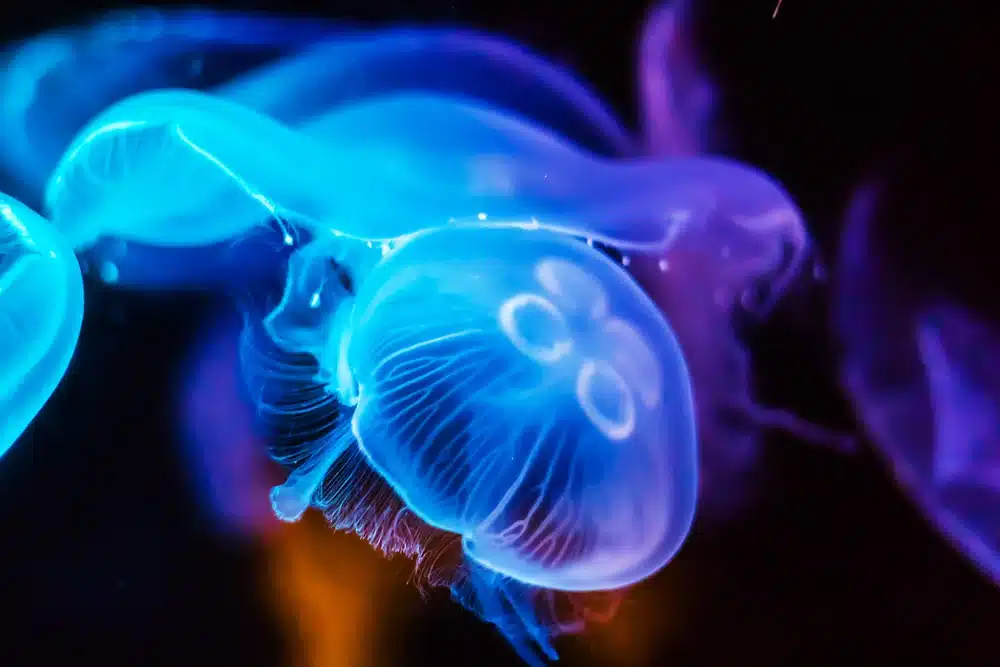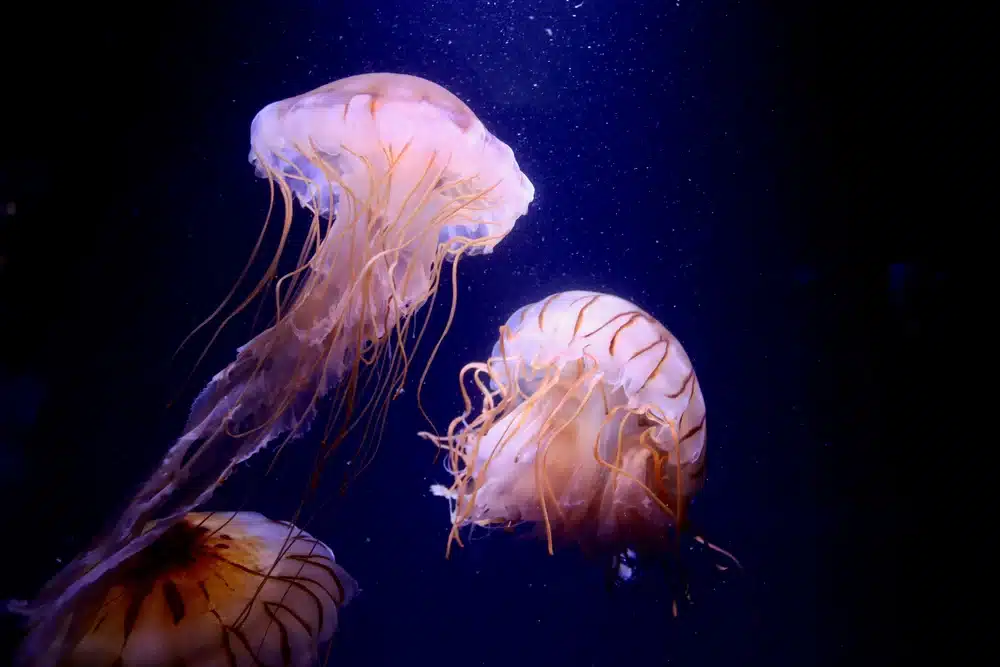What Do Jellyfish Eat

Introduction
What Do Jellyfish Eat: Jellyfish, those mesmerizing and enigmatic creatures that gracefully drift through the world’s oceans, have long fascinated scientists and curious minds alike. While their captivating pulsating movements and translucent bodies have garnered attention, their dietary habits remain a subject of intrigue. Understanding what jellyfish eat is a vital piece of the puzzle in unraveling the intricate dynamics of marine ecosystems.
In essence, jellyfish are carnivorous organisms, but their diet is not as straightforward as that of many other animals. They are opportunistic predators that primarily feed on a diet of small aquatic creatures, fittingly adapted to their unique hunting strategy.
At the heart of a jellyfish’s feeding mechanism are its stinging tentacles, which hang beneath its bell-shaped body, waiting to ensnare unsuspecting prey. These tentacles are armed with specialized cells called cnidocytes, which contain harpoon-like structures known as nematocysts. When a potential meal comes into contact with these tentacles, the nematocysts explosively release toxins, immobilizing or killing the prey and making it easier for the jellyfish to consume.
Their diet primarily consists of plankton, small fish, fish eggs, and other microscopic organisms that populate the ocean’s depths. Their translucent appearance belies their carnivorous nature, as they skillfully capture and ingest their prey using a process known as filter feeding or passive predation.
As we delve deeper into the intriguing world of jellyfish feeding habits, we will uncover the mechanisms they employ to secure their sustenance and the vital role they play in maintaining the delicate balance of our marine ecosystems.

What is a jellyfish’s favorite food?
Diet. The typical jelly eats small, swimming organisms called plankton: a mixture of tiny creatures like amphipods, copepods and krill. It also eats larval shrimps, crabs, fish and even other jellies.
A jellyfish’s favorite food primarily consists of plankton, tiny aquatic organisms that populate the world’s oceans. These gelatinous creatures are opportunistic predators, and while they predominantly feed on plankton, their diet can also include small fish, fish eggs, and other microscopic organisms.
Jellyfish are uniquely adapted for capturing their preferred prey. They possess long, trailing tentacles armed with specialized cells called cnidocytes. These cnidocytes contain harpoon-like structures known as nematocysts, which are loaded with venomous toxins. When a jellyfish encounters potential food, its tentacles swiftly coil around the prey, and the nematocysts are discharged, paralyzing or killing the victim. Once immobilized, the jellyfish can then bring the captured food to its mouth, located in the center of its bell-shaped body.
While jellyfish typically consume plankton and other small marine organisms, their favorite food can vary depending on their species, size, and the availability of prey in their environment. They are highly adaptable, adjusting their diet to the prevailing conditions, which contributes to their success as opportunistic feeders in the ever-changing world of the ocean.
What do jellyfish eat facts?
Jellyfish digest their food, which consists of fish, shrimp, crabs and tiny plants, very quickly. If they didn’t, they wouldn’t be able to float, being weighed down by the large, undigested grub in their body.
Jellyfish, those mesmerizing drifters of the deep, subsist on a diet primarily composed of plankton, small fish, and various microscopic organisms. Here are some intriguing facts about what jellyfish eat:
Plankton Predators: Jellyfish are voracious consumers of plankton, which includes tiny plants (phytoplankton) and animals (zooplankton) that drift in the ocean currents. They use their specialized tentacles to capture these minuscule organisms.
Opportunistic Feeders: While plankton forms the core of their diet, jellyfish are opportunistic feeders. They adapt to their surroundings and will consume small fish, fish eggs, and other tiny marine creatures when available.
Efficient Predators: Jellyfish employ a unique hunting technique. Their tentacles are armed with cnidocytes containing nematocysts, which are essentially harpoon-like structures. When a potential meal brushes against these tentacles, the nematocysts shoot out, injecting toxins into the prey, immobilizing or killing it for easy consumption.
Sustaining Marine Ecosystems: Jellyfish play an essential role in marine ecosystems by controlling the populations of their prey, particularly plankton. This, in turn, affects the dynamics of the entire food web in oceans.
Global Impact: Jellyfish blooms, or large gatherings of jellyfish, can impact fisheries and disrupt ecosystems. Understanding their diet and feeding habits is crucial for managing these blooms and preserving marine biodiversity.
Sensitivity to Environmental Changes: Changes in water temperature, pollution, and overfishing can influence jellyfish populations and their food sources, making them important indicators of environmental health.
Intriguingly, while jellyfish may seem delicate and passive, their diet and predatory tactics reveal a more complex and adaptable nature, contributing to their survival in the ever-evolving world beneath the waves.
Do jellyfish eat fish food?
Generally speaking, jellyfish are known to be opportunistic feeders, meaning they can eat almost anything that they come across while swimming. Some species are specific feeders, which means they only consume small fish eggs. Other species devour a whole fish as their meal.
Jellyfish typically do not eat traditional fish food as provided in aquariums. Unlike pet fish, jellyfish have specific dietary requirements and feeding mechanisms that make them challenging to care for in a home aquarium setting.
In their natural habitat, jellyfish primarily feed on plankton, small fish, fish eggs, and other tiny marine organisms. They capture their prey using their stinging tentacles, which are armed with specialized cells called cnidocytes containing venomous nematocysts. When prey comes into contact with these tentacles, the nematocysts discharge, immobilizing or killing the prey.
Feeding jellyfish in captivity is a complex process that involves providing live or appropriately sized food items that mimic their natural diet. This often includes newly hatched brine shrimp, zooplankton, or specialized jellyfish food products designed for the specific nutritional needs of jellyfish. Feeding must be carefully managed to avoid overfeeding, as uneaten food can decompose and affect water quality in the tank.
Jellyfish do not eat traditional fish food, and their dietary requirements are quite different from those of common pet fish. Properly caring for jellyfish in captivity requires a thorough understanding of their unique feeding habits and specialized nutritional needs.
Do all jellyfish eat fish?
They feed on very small animals that they catch within their tentacles. A jellyfish diet generally consists of copepods, fish larvae, fish eggs, phytoplankton, and planktonic eggs. Some jellyfish will even eat other jellyfish. Larger jellyfish may also feed on crabs, shrimp, and fish.
In fact, the dietary preferences of jellyfish can vary widely among different species. While some jellyfish do incorporate small fish into their diet, many primarily feed on plankton, which consists of tiny plants (phytoplankton) and animals (zooplankton) that drift in ocean currents.
Jellyfish are diverse in their feeding strategies. Here are a few examples:
Planktivorous Jellyfish: A significant portion of jellyfish species are planktivores, meaning they feed primarily on plankton. They use their tentacles and specialized stinging cells to capture these microscopic organisms, which make up the bulk of their diet.
Carnivorous Jellyfish: Some jellyfish, particularly larger species, may include small fish, fish eggs, and other small marine creatures in their diet. They employ their stinging tentacles and venomous nematocysts to immobilize these larger prey items.
Filter-Feeding Jellyfish: Certain jellyfish species engage in filter feeding, where they passively collect plankton and other particles from the water using mucous-covered tentacles or oral arms. These jellyfish rely primarily on plankton as their source of food.
The specific diet of a jellyfish often depends on its size, habitat, and environmental conditions. Not all jellyfish have a preference for fish, and many are more attuned to capturing the abundant plankton that populates the oceans. Understanding the feeding habits of different jellyfish species is essential for comprehending their role in marine ecosystems.
Are jellyfish poisonous?
Though the venom of most jellyfish is not harmful, some can be deadly. For example, the Indo-Pacific box jellyfish—or sea wasp—releases venom that makes the heart contract. There is an antidote, but the poison acts fast, so someone who is stung must seek medical attention immediately.
The term “poisonous” refers to an organism’s ability to produce toxins that can harm or incapacitate potential threats or prey. In the case of jellyfish, their poison is contained in specialized cells called cnidocytes, which are located in their tentacles. These cnidocytes contain tiny harpoon-like structures known as nematocysts, loaded with venom.
When a jellyfish comes into contact with a potential threat or prey, it releases its nematocysts, shooting them into the target. The venom delivered by these nematocysts can vary in potency among different jellyfish species. Some jellyfish have venom that is relatively mild, causing skin irritation and discomfort, while others possess highly potent toxins that can be life-threatening to humans and other animals.
Famous examples of highly venomous jellyfish include the box jellyfish (Chironex fleckeri) and the Portuguese man o’ war (Physalia physalis). Encounters with these jellyfish can result in severe stings that require immediate medical attention.
Many regions with jellyfish populations have safety guidelines and warnings in place to help prevent stings. Proper first aid measures, such as rinsing the affected area with vinegar and seeking medical attention, are crucial in the event of a jellyfish sting to mitigate the effects of their venom.
Do jellyfish have blood?
They also have no heart, bones or blood and are around 95% water! So how do they function without a brain or central nervous system? They have a basic set of nerves at the base of their tentacles which can detect touch, temperature, salinity etc.
Jellyfish, fascinating creatures of the ocean, possess a circulatory system that differs significantly from vertebrates like humans. Instead of blood, they rely on a gelatinous substance known as “hemolymph.” This fluid serves a similar purpose, transporting nutrients, oxygen, and waste products throughout their bodies. Unlike the complex circulatory systems of mammals, jellyfish have a simple network of canals and sacs that facilitate the movement of hemolymph.
Within their translucent bodies, the hemolymph flows, bathing the various cells and tissues. This unique system allows jellyfish to survive in their aqueous environment, where the exchange of gases and nutrients occurs directly through their delicate epidermis. The absence of a true circulatory system doesn’t hinder their survival; in fact, it contributes to their graceful, undulating movements through the water.
The hemolymph also plays a crucial role in maintaining the jellyfish’s buoyancy. By regulating its salinity levels, these enigmatic creatures can rise and sink in the water column, effectively controlling their position in the vast expanse of the ocean. This adaptation highlights the remarkable resilience and adaptability of jellyfish, enabling them to thrive in a diverse range of marine environments around the world. In their elegant simplicity, jellyfish continue to intrigue scientists and ocean enthusiasts alike, inviting further exploration into the mysteries of the deep sea.
How do jellyfish catch their prey?
Jellyfish, mesmerizing denizens of the deep, employ a deceptively simple yet highly effective method to catch their prey. Drifting through the ocean currents, they rely on a combination of specialized anatomical features and strategic hunting tactics.
At the heart of their predatory prowess are the stinging cells called nematocysts, which adorn their tentacles. When a potential meal comes into contact with these microscopic harpoons, they fire with astonishing speed, injecting venom into the prey. This paralyzes or kills the target, rendering it immobile and ready for consumption.
Jellyfish are remarkably sensitive to changes in their aquatic environment. They possess rudimentary sensory organs that can detect vibrations and chemical cues, helping them locate potential meals. Some species are also phototactic, meaning they are drawn towards light, which can lead them to areas where prey is more abundant.
Once the prey is ensnared, the jellyfish’s tentacles contract, bringing the incapacitated creature towards the central mouth. This central opening acts as both the entrance for food and the exit for waste. The jellyfish’s digestive system is relatively simple, allowing for efficient absorption of nutrients.
This elegant yet lethal hunting strategy has allowed jellyfish to thrive in oceans worldwide, adapting to a wide range of ecosystems. Their success as predators is a testament to the marvels of natural evolution and the intricacies of life beneath the waves.
Can jellyfish survive without food for extended periods?
Jellyfish exhibit a remarkable ability to endure extended periods without food, a trait that contributes to their adaptability and survival in various marine environments. Their capacity to withstand scarcity arises from their unique biology and the opportunistic nature of their feeding habits.
When food is scarce, jellyfish enter a state of metabolic dormancy known as quiescence. They reduce their energy expenditure and rely on stored nutrients within their gelatinous bodies. This enables them to withstand prolonged periods of starvation, sometimes spanning several weeks or even months.
Jellyfish are highly opportunistic feeders. They do not rely on regular, large meals for sustenance. Instead, they can capitalize on sporadic encounters with prey, making them adept at thriving in dynamic and unpredictable oceanic conditions.
This ability to endure extended periods without food allows jellyfish to persist through fluctuations in food availability, giving them a competitive edge in ecosystems where resources are variable. It also underscores their resilience in the face of environmental challenges, making them one of the most enduring and adaptable creatures in the world’s oceans.

Conclusion
In the realm of marine biology, the question of what jellyfish eat might appear deceptively simple, yet it unravels a fascinating story of adaptation and ecological significance. These ethereal creatures, with their pulsating bell-shaped bodies and trailing tentacles, are more than just mesmerizing spectacles; they are key players in the intricate dance of life beneath the ocean’s surface.
Jellyfish, despite their simplicity in form and function, employ a sophisticated strategy to secure their meals. Armed with stinging tentacles and venomous nematocysts, they efficiently capture plankton, small fish, fish eggs, and other microscopic organisms that populate the vast expanse of the world’s oceans. Their diet, characterized by filter feeding and passive predation, reflects their role as opportunistic predators.
Beyond their unique feeding habits, jellyfish serve a crucial role in marine ecosystems. They act as regulators, controlling the populations of their prey species and influencing the balance of oceanic food webs. Understanding what jellyfish eat is not just a matter of curiosity but a fundamental aspect of comprehending the broader ecological dynamics of our oceans.
The enigmatic diet of jellyfish underscores the complexity of life in the ocean and the interconnectedness of species within these ecosystems. By peering into the world of these graceful yet deadly predators, we gain a deeper appreciation for the intricacies of nature and the importance of preserving the delicate equilibrium of our marine environments.



